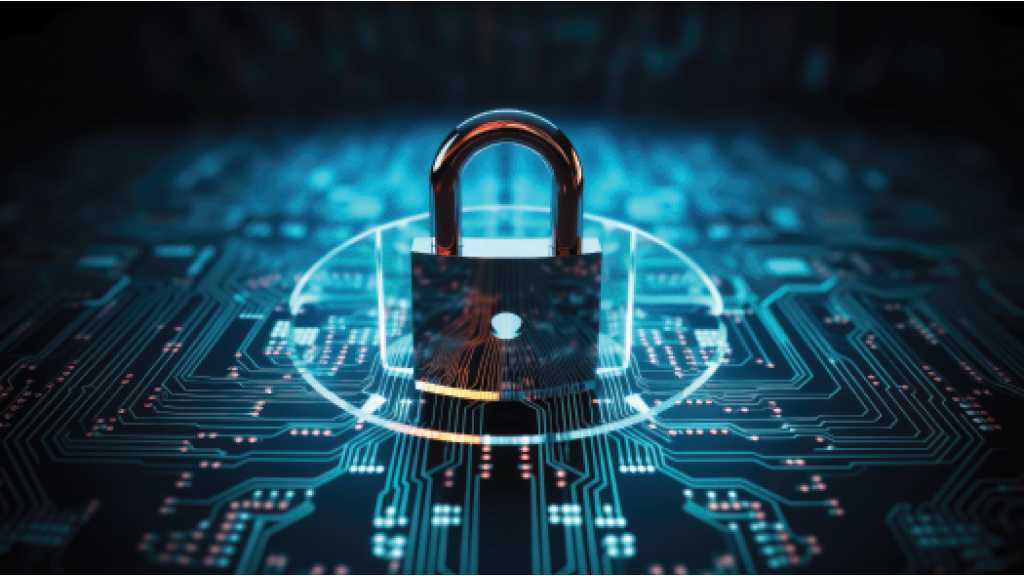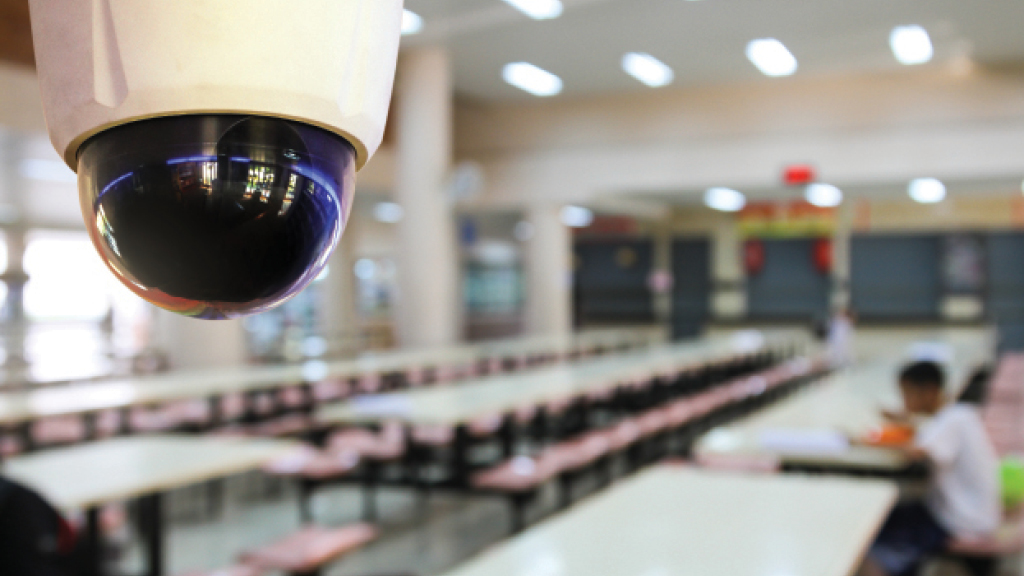TITIKUL_B/STOCK.ADOBE.COM
The number of school shootings with casualties in U.S. schools continues to break record highs. According to the K-12 School Shooting Database, there were 305 shooting incidents on school grounds in 2022, compared to 250 in 2021 and 115 in 2020. If current trends continue, the database projects that number to be closer to 340 in 2023.
A ubiquitous security tool in schools, security cameras allow for forensic review. However, they don’t detect threats in real time. That’s why school districts—especially after the May 2022 elementary school massacre in Uvalde, Texas—increasingly are turning to artificial intelligence to prevent school violence. Yet, these investments aren’t without questions about privacy, effectiveness, false alarms, and other concerns.
“You can’t always control what happens, but you can control the response,” says Tom Poehlmann, director of safety, security, and operations for Delaware’s Appoquinimink School District.
Appoquinimink school officials had been monitoring artificial intelligence security trends for years. Then a couple of incidents during athletic events in 2022-23, including the discharge of a gun during a fight outside a basketball game, caused them to turn to artificial intelligence for a potential solution.
“Most times, school officials try to make the right decision, but we are human, and sometimes we just don’t,” Poehlmann says. “By and large, however, people appreciate action over inaction, and we have tried to take action in order to mitigate the chances of this happening again.”
A ‘near unanimous’ vote for artificial intelligence
Virginia’s Prince William County Public Schools led extensive discussions—at school board meetings, town halls, and advisory councils comprised of school officials and parents—before installing weapons detection scanners in all 34 middle and high schools by the end of September.
The scanners are manufactured by Evolv Technology, whose security technology is used in approximately 650 schools nationwide. The system uses algorithms and different signatures of potential weapons to identify threats even when concealed, allowing for quicker and less invasive entrances.
“It was near unanimous that people wanted it,” School Board Chairman Babur Lateef says of the purchase, which will cost about $10.7 million over four years and be paid from the operating budget. “And I’m talking folks who are advocates on both the far right and the far left of our political spectrum.”
Prince William County Public Schools, with 90,000 students, was wrestling with a worrisome statistic. In 2019-20, it found 25 weapons in schools; that number soared to 71 in 2021-22, dipping only slightly to 61 in 2022-23.
In addition, a schoolwide survey found that 88% of elementary students and 76% of secondary students reported feeling safe at school during the 2022-23 school year. The district’s goal for that statistic is to reach at least 90%.
Lateef points out that even with the added security, the new technology is not without fault: “Evolv was clear that this is not a perfect system, and we are very clear that this is an added layer of security—and that none of our layers are perfect.”
Critics challenge effectiveness
There has been “little to no significant research” on the use of artificial intelligence for school security and safety in these “highly ambiguous and uncertain times,” according to Ken Trump, president of National School Safety and Security Services, a national consulting firm based in Cleveland, Ohio. [See Trump’s article on page 24]
“When there are high-profile school security incidents, there’s an enormous amount of pressure on school administrators and board members to do something and do it fast,” he says. “That may temporarily address a political and school community relations problem, but it typically does not solve a school safety problem.”
School officials have a daunting challenge when interpreting and understanding what companies are offering in AI in general, and particularly as it relates to security technology, according to Donald Maye, head of operations for IPVM. The industry research group reports on physical security technology, including weapons detection.
Some companies are so “aggressive and wildly misleading with their marketing claims that they’re deceptive,” he says.
Maye urges companies to be forthcoming about security system weak points such as AI-related false alerts, which happen because technology can’t always differentiate between a gun and a computer or binder, for instance. IPVM, through its own testing and Freedom of Information Law requests, found that false alerts happen regularly.
Trump says he wishes more school districts made AI-related security decisions based on their own needs, rather than on panic or trends. He has seen clusters of school districts snapping up weapons detection systems after hearing about a nearby school district doing the same thing.
“Does it make sense to spend hundreds of thousands of dollars, or potentially millions, for a novel high-tech product out of fear of an active school shooter—which most schools will never experience—and sustain those costs for all years moving forward?” Trump asks. “Or are you going to take a tactical pause in your thinking and have a comprehensive assessment of security threats, risks, and vulnerabilities, then spend limited resources on addressing issues more likely to impact day-to-day school safety?”

VIZ/STOCK.ADOBE.COM
AI-based security systems grow rapidly
A pioneer decades ago in what became known as the emergency mass notification market, Omnilert launched an artificial intelligence-powered visual gun detection technology in late 2020. The market for that technology began to develop in early 2022, and just over a year later sales had risen twentyfold.
Schools make up half of the company’s customer base. One of its latest contracts is with Maryland’s Baltimore County Public Schools. The district plans to integrate the software with its 7,000 existing cameras, representing one of the largest deployments of visual gun detection technology in the country.
“When a gun is sighted, it takes less than a second for the detection to be made and [the technology] immediately sends images and precise location to a human in the loop for verification,” says Dave Fraser, CEO of Omnilert, based in Leesburg, Virginia.
That human could be at an Omnilert monitoring center, part of the customer’s security team, or a third-party monitoring service of the customer’s choice. Once verified, the information is sent immediately to first responders, and automated lockdowns—which can include locking doors, sounding alarms, and notifying those in harm’s way—can be initiated.
More than one weapons-detection company has employees with ties to school violence.
Omnilert’s director of artificial intelligence, Chad Green, lost a family member in the 2012 Sandy Hook Elementary School shooting, which took the lives of 20 students and six adults.
At Evolv, Director of Education Jill Lemond was assistant superintendent of student services at Michigan’s Oxford Community Schools when four students were murdered, and seven other people injured during a mass shooting at Oxford High School in November 2021. Afterward, Lemond, who had been working with the police, was put in charge of all security for the district. That’s how she first connected with Evolv, which donated three weapons detection systems to the high school. She went to work for the company in October 2022.
Evolv technology screens about 250,000 students a day—a tenfold increase over the past year, according to Lemond.
As for privacy concerns, Lemond says that AI images are never shared. They belong solely to the district and allow for enhanced security without making students open or empty their bags as they walk through the door.
‘We had a problem and we had to address the problem’
Appoquinimink’s incidents spurred investments in Evolv and ZeroEyes, an artificial intelligence gun detection and situational awareness platform used with existing security cameras. If a gun is detected, the software instantly sends images to a center staffed 24 hours a day, seven days a week, by specially trained U.S. military and law enforcement veterans. If the threat is viable, a visual description, gun type, and last known location is dispatched to local staff and first responders in as little as three to five seconds.
“I’m not reactionary and I’m not panicky,” says Poehlmann, in charge of security for the 13,000-student district. “We had a problem and we had to address the problem.”
For the 2023-24 school year, Appoquinimink is paying roughly $124,000 for three devices—one for each high school stadium—and about $45,000 for 120 camera streams where athletic events take place.
White Plains City School District in New York also is using ZeroEyes in each of the 7,000-student district’s indoor and outdoor security cameras.
Any decision having to do with security needs to be “measured to make sure we’re preserving a warm, welcoming climate and culture” in schools, says White Plains Superintendent Joseph Ricca. AI allows that to happen “without being obtrusive.”
To that point, students at Santa Fe High School in Santa Fe, New Mexico, warmly received a 400-pound surveillance robot—with the ability to adopt artificial intelligence—from the start of a recent pilot, slated to end this fall. The all-terrain robot, from Team 1st Technologies based in Albuquerque, patrols the sprawling grounds 24/7. It can send messages of potential threats to authorities and allow a remote security team to speak to an intruder.
“Some of the kids will wave to it, talk to it, give salutations to the robot—it’s kind of comical,” says Mario Salbidez, executive director of safety and security for Santa Fe Public Schools, which has 11,500 students. “It’s nice to see they seem to be accepting the robot on their campus.”
If the robot winds up a permanent fixture—at a cost of less than $9 a day—students will have the opportunity to name it. In the meantime, Salbidez is hoping to add a robot to another district high school.
Never giving up
District officials know that no security measure—not even one powered by artificial intelligence—can guarantee a safe environment all the time.
But they can’t relax efforts to keep trying to do just that, according to Prince William County’s Lateef.
“What always comes up, both from the teachers and the parents, is ‘If a shooting happens, can you say to us you did everything you possibly could to prevent that from happening?’” Lateef says. “That’s the magic question.”
Robin L. Flanigan (robin@thekineticpen.com) is a freelance writer in Rochester, New York.


Share this content